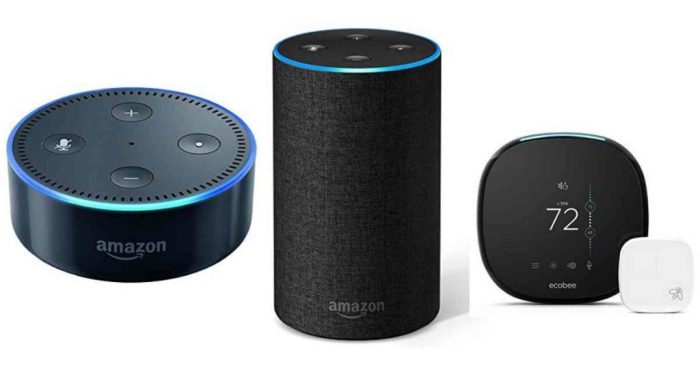Alexa’s Expansion in 2018
In 2018, Alexa, Amazon’s voice assistant, experienced a significant expansion, becoming integrated into a wide range of devices beyond its initial home speaker ecosystem. This strategic move aimed to establish Alexa as a ubiquitous presence in everyday life, making it accessible across various contexts and devices.
Key Devices for Alexa Expansion in 2018
The year 2018 witnessed a significant push to integrate Alexa into diverse devices, broadening its reach beyond the realm of smart speakers. Here are some of the key devices that embraced Alexa integration:
- Smartphones: Alexa’s integration into smartphones was a pivotal step in its expansion. Users could access Alexa directly through dedicated apps on both Android and iOS devices. This provided seamless voice control capabilities for various tasks, from setting reminders to controlling smart home devices, right from their phones.
- Cars: The automotive industry became a prime target for Alexa’s expansion. Several car manufacturers, including Ford, Toyota, and BMW, integrated Alexa into their infotainment systems. This enabled drivers to control music, navigation, and other car functions using voice commands.
- Smart Displays: The emergence of smart displays, like Amazon’s Echo Show and Lenovo’s Smart Display, brought a new dimension to Alexa’s capabilities. These devices combined the functionality of a smart speaker with a visual interface, allowing users to view information, make video calls, and control smart home devices visually.
- Smart Home Devices: Alexa’s integration into smart home devices, such as smart lights, thermostats, and security systems, significantly enhanced user convenience. This enabled users to control these devices through voice commands, creating a more intuitive and hands-free experience.
- Wearables: Wearable devices like smartwatches and fitness trackers also embraced Alexa integration. Users could control music playback, set reminders, and access information using voice commands directly from their wrists.
Market Impact of Alexa Expansion
The expansion of Alexa into various devices had a profound impact on the market. Here are some key observations:
- Increased Adoption: The integration of Alexa into a wider range of devices significantly increased its adoption rate. Users could now access Alexa’s functionality in various contexts, leading to increased usage and familiarity with the voice assistant.
- Enhanced Competition: Alexa’s expansion into diverse devices intensified competition in the voice assistant market. Google Assistant and Apple’s Siri faced increased pressure to keep pace with Alexa’s growing presence across various platforms.
- New Opportunities: The expansion of Alexa opened up new opportunities for businesses and developers. By integrating Alexa into their products, companies could enhance user experience and create new revenue streams.
Features and Functionalities of Alexa Across Devices
Alexa’s functionalities varied slightly across different devices, reflecting the unique capabilities and limitations of each platform. However, core functionalities remained consistent across devices:
- Voice Control: All Alexa-enabled devices offered voice control as the primary mode of interaction. Users could issue commands to Alexa to perform tasks, such as playing music, setting reminders, and controlling smart home devices.
- Music Playback: Alexa provided access to a wide range of music streaming services, including Amazon Music, Spotify, and Apple Music, allowing users to enjoy their favorite tunes through voice commands.
- Smart Home Control: Alexa’s ability to control smart home devices was a key feature. Users could turn lights on and off, adjust thermostats, and lock doors using voice commands.
- Information Retrieval: Alexa could provide information on a variety of topics, including weather forecasts, news updates, and definitions.
- Skill Ecosystem: Alexa’s skill ecosystem provided access to thousands of third-party applications, extending its functionalities beyond core features.
User Experience of Alexa on Expanded Devices
The user experience of Alexa varied across different devices, depending on the specific features and functionalities offered. However, some common themes emerged:
- Convenience: Alexa’s voice control capabilities provided a convenient way to interact with devices, particularly in situations where using a touchscreen or physical buttons was impractical or inconvenient.
- Personalization: Users could personalize Alexa’s settings to suit their preferences, including voice profiles, music playlists, and smart home device configurations.
- Seamless Integration: Alexa’s integration into various devices created a seamless experience, allowing users to access its functionalities across different platforms without needing to switch between applications or devices.
Drivers of Alexa Expansion
In 2018, Amazon’s Alexa experienced a significant expansion, becoming integrated into a wider range of devices. This strategic move was driven by a combination of factors, including market trends, competitive pressures, and a vision to establish Alexa as the dominant voice assistant platform.
Strategic Goals
Amazon’s strategic goals behind expanding Alexa’s reach were multifaceted:
- Dominate the Smart Home Market: Amazon aimed to establish Alexa as the central hub for controlling smart home devices, offering users a seamless experience across various appliances and systems. This strategy aimed to capture a larger share of the rapidly growing smart home market.
- Increase User Adoption and Engagement: By integrating Alexa into more devices, Amazon sought to increase user adoption and engagement with its voice assistant platform. This would lead to greater data collection, enabling Amazon to further refine Alexa’s capabilities and personalize user experiences.
- Expand Revenue Streams: Expanding Alexa’s reach into new device categories opened up new revenue streams for Amazon. The company could generate income from hardware sales, subscriptions for premium features, and advertising revenue based on user data.
Competitive Landscape
In 2018, the smart home and voice assistant market was becoming increasingly competitive. Google Assistant, Apple Siri, and Microsoft Cortana were all vying for market share. Amazon recognized the need to expand Alexa’s presence and capabilities to stay ahead of the competition.
Market Trends and User Needs, Alexa will be expanded to more devices in 2018
The expansion of Alexa was driven by several key market trends and user needs:
- Growing Demand for Voice Control: Consumers were increasingly adopting voice control for various tasks, driven by the convenience and ease of use offered by voice assistants. Alexa’s expansion aimed to capitalize on this growing demand.
- Increased Connectivity of Devices: The proliferation of connected devices in the home created an opportunity for a centralized voice assistant platform like Alexa to manage and control these devices seamlessly.
- Desire for Personalized Experiences: Users were seeking personalized experiences, with voice assistants learning their preferences and providing tailored recommendations. Alexa’s expansion aimed to leverage data to deliver more personalized experiences.
Impact of Alexa Expansion
Alexa’s expansion beyond its initial Echo device has had a profound impact on Amazon’s business and the wider smart home technology landscape. This expansion has been driven by the integration of Alexa into a vast array of devices, from smartphones and tablets to cars and appliances. The increased accessibility and ubiquity of Alexa have led to significant growth in user adoption and a transformation in how people interact with technology.
Amazon’s Business Impact
The expansion of Alexa has been a significant driver of Amazon’s growth. The integration of Alexa into various devices has created a vast ecosystem of connected products, increasing customer engagement and loyalty. By providing a seamless and intuitive user experience across multiple devices, Amazon has solidified its position as a leading player in the smart home market.
User Adoption Rate
Alexa’s user adoption rate has grown exponentially since its launch. According to Statista, as of January 2023, there were over 100 million Alexa-enabled devices in use globally. This widespread adoption can be attributed to factors such as the ease of use, the availability of a wide range of skills, and the integration of Alexa into a diverse range of devices.
Challenges and Opportunities
The expansion of Alexa has also presented both challenges and opportunities. One key challenge is ensuring data privacy and security as users increasingly rely on Alexa for personal information. Amazon has addressed this by implementing robust security measures and providing users with control over their data.
Another challenge is maintaining a consistent user experience across different devices and platforms. Amazon has invested heavily in ensuring a seamless experience, regardless of the device or platform being used. This has involved developing a comprehensive platform for developers and ensuring compatibility with a wide range of hardware.
The expansion of Alexa has also created opportunities for Amazon to expand its business into new markets. For example, the integration of Alexa into automobiles has opened up new possibilities for in-car entertainment, navigation, and connected services.
Influence on Smart Home Technology
Alexa’s expansion has been instrumental in driving the development of smart home technology. The availability of a voice-controlled platform has encouraged manufacturers to develop a wide range of connected devices, from smart lights and thermostats to security systems and appliances. This has led to a surge in innovation and a more connected and convenient home environment.
Alexa’s ability to integrate with a wide range of devices has also simplified the process of creating a smart home. Users can now control multiple devices with a single voice command, making it easier than ever to create a truly connected home.
Future Implications of Alexa Expansion: Alexa Will Be Expanded To More Devices In 2018
Alexa’s expansion in 2018 marked a pivotal moment in the evolution of voice technology. It not only brought smart home devices to a wider audience but also laid the groundwork for a future where voice interactions become increasingly ubiquitous. The implications of this expansion are far-reaching, impacting various aspects of our lives, from how we interact with technology to the way we live and work.
Potential for Future Growth and Innovation in the Smart Home Market
The widespread adoption of Alexa in 2018 significantly accelerated the growth of the smart home market. This growth is driven by several factors, including:
- Increased affordability and accessibility: The availability of a wide range of Alexa-enabled devices at various price points made smart home technology accessible to a broader audience.
- Enhanced user experience: Alexa’s intuitive voice interface and seamless integration with various smart home devices made it easy for users to control their homes with voice commands.
- Expanding ecosystem: The growing number of third-party developers creating Alexa skills opened up a vast array of possibilities for smart home functionality, extending beyond basic controls.
The continued expansion of Alexa and other voice assistants will drive further innovation in the smart home market. We can expect to see advancements in areas such as:
- Personalized automation: Voice assistants will become increasingly sophisticated in understanding individual user preferences and automatically adjusting home settings based on context, time of day, and user behavior.
- Proactive assistance: Voice assistants will anticipate user needs and provide assistance before they are even requested, such as automatically adjusting the thermostat based on weather conditions or reminding users of upcoming appointments.
- Enhanced security and safety: Voice assistants will play a crucial role in enhancing home security, providing features like remote monitoring, intrusion detection, and emergency response.
Alexa will be expanded to more devices in 2018 – The impact of Alexa’s expansion in 2018 is undeniable. It spurred innovation in smart home technology, created a new level of convenience for users, and propelled Amazon’s dominance in the voice assistant market. This expansion was a game-changer, laying the groundwork for the future of voice technology. As we move forward, we can expect even more integrated and intuitive voice-controlled experiences, making our lives easier and more connected than ever before. The 2018 Alexa expansion wasn’t just a moment in time; it was a turning point in the evolution of technology, and its ripple effects continue to be felt today.
Alexa is about to become even more ubiquitous in 2018, with plans to expand to a wider range of devices. This push for wider adoption might be inspired by the recent news that Cyanogen and Microsoft are teaming up to bring apps and services to Cyanogen OS, a move that could see Alexa integrated into a broader range of Android devices.
This means that Alexa could be on everything from your smart home devices to your smartphone, making it easier than ever to control your world with your voice.
 Standi Techno News
Standi Techno News

